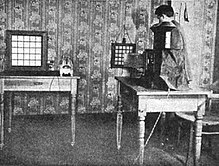History of Television § Broadcasting
History
The invention of the television was
the work of many individuals in the late 19th century and early 20th century.
Individuals and corporations competed in various parts of the world to deliver
a device that superseded previous technology. Many were compelled to capitalize
on the invention and make profit, while some wanted to change the world through
visual and audio communication technology.[1]
The first mechanical raster scanning techniques were developed
in the 19th century for facsimile, the transmission of still images by
wire. Alexander Bain introduced the facsimile machine in 1843 to
1846. Frederick Bakewell demonstrated a working laboratory version in
1851. The first practical facsimile system, working on telegraph lines, was
developed and put into service by Giovanni Caserlli from 1856 onward.
Willoughby Smith discovered the photoconductivity of
the element selenium in 1873, laying the groundwork for the selenium
cell phototube which was used as a pickup in most mechanical scan systems.
The first demonstration of
the instantaneous transmission of images was made by a German
physicist, Ernst Ruhmer, who arranged 25 selenium cells as the picture
elements for a television receiver. In late 1909 he successfully demonstrated
in Belgium the transmission of simple images over a telephone wire from
the Palace of Justice at Brussels to the city of Liege, a distance of
115 kilometers (72 miles). This demonstration was described at the time as
"the world's first working model of television apparatus". The
limited number of elements meant his device was only capable of representing
simple geometric shapes, and the cost was very high; at a price of £15 (US$45)
per selenium cell, he estimated that a 4,000 cell system would cost £60,000
(US$180,000), and a 10,000 cell mechanism capable of reproducing "a scene
or event requiring the background of a landscape" would cost £150,000
(US$450,000). Ruhmer expressed the hope that the 1910 Brussels Exposition
Universelle et Internationale would sponsor the construction of an
advanced device with significantly more cells, as a showcase for the
exposition. However, the estimated expense of £250,000 (US$750,000) proved to
be too high.
The publicity generated by Ruhmer's demonstration spurred two
French scientists, Georges Rignoux and A. Fournier in Paris, to announce
similar research that they had been conducting. A matrix of 64 selenium cells,
individually wired to a mechanical commutator, served as an electronic
retina. In the receiver, a type of Kerr cell modulated the light and a
series of variously angled mirrors attached to the edge of a rotating disc
scanned the modulated beam onto the display screen. A separate circuit
regulated synchronization. The 8x8 pixel resolution in this
proof-of-concept demonstration was just sufficient to clearly transmit
individual letters of the alphabet. An updated image was transmitted
"several times" each second.
In 1911, Boris Rosing and his student Vladimir
Zworykin created a system that used a mechanical mirror-drum scanner to
transmit, in Zworykin's words, "very crude images" over wires to the
"Braun tube" (cathode ray tube or "CRT") in the
receiver. Moving images were not possible because, in the scanner, "the
sensitivity was not enough and the selenium cell was very laggy".





Comments
Post a Comment